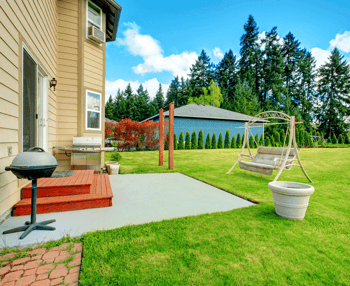 A deck or patio offers ample room for entertaining family and friends during a hot Calgary summer; but which one is right for you?
A deck or patio offers ample room for entertaining family and friends during a hot Calgary summer; but which one is right for you?
Check out these pros and cons of each.
The Patio Advantage
A patio is a square or rectangular pad of concrete poured flush with your home’s foundation—either during construction or added later.
Consider some advantages to having a patio:
1. Easier access to the ground
A patio’s ground level installation might be easier to manoeuvre for senior adults and pets who need access to the grounds without climbing stairs. A patio accessed through a sliding glass door also makes outdoor entertaining a breeze.
2. Indestructible and low maintenance
You can hose your concrete patio down as often as you like without fear of wood rot or moisture retention. With proper drainage, a patio offers a clean, dry surface for family barbecues or casual gatherings and should last as long as the house.
3. Attractive to potential buyers
An attached patio gets high marks from new home buyers who can envision using an outdoor space like a patio as an extra “room.” Add some outdoor furniture, a barbecue grill or outdoor kitchen, and a patio cover or umbrella for hours of family fun—rain or shine!
4. Can be customized
Take your concrete patio from drab to fab with pavers, a knee wall, or a pergola. The idea is to make your outdoor space more attractive and inviting. For a custom look, add brick or concrete pavers on the top surface of your patio. Pavers beautify your backyard and hide imperfections like stains, cracks, or chips.
5. Free on a new home build
Builders can usually include a concrete patio and driveway as part of your new home building plan. It’s much easier to form and pour a patio and footer at the time of construction when driveways and sidewalks are being poured. Builders and homebuyers save money on materials, labour, and the headache of having to come back and grade, form, and pour a patio after the home is completed.
A few cons:
1. Concrete patios can crack and stain
The porous properties of concrete make it easier to crack and stain than a deck constructed from hard woods or composites. Constant exposure to the elements –especially sun, water, and acid rain – wreak havoc and turn your patio into an eyesore.
2. Uneven slabs can hold water
Over time a concrete slab can crack, expand, contract, or shift and cause water to pool on the surface and turn to ice when winter temps drop. Icy patios can also cause falls and require constant cold weather maintenance.
3. Concrete reflects the heat
During summer months, your patio can become unbearably hot, especially if there is no cover or awning. You can almost fry an egg on concrete pavement, whereas a wooden deck will help you stay cooler longer.
The Benefits of Building a Deck
Typically constructed from wood or a manmade composite, decks are attached to the house or built as a standalone structure on a raised platform.
Some pros to new deck construction include:
1. Increased retail value
Statistics indicate potential home buyers are more likely to buy a house with a deck rather than a patio — good news for sellers who stand to reap an 87% return on resale.
2. Decks can be constructed over uneven terrain.
Unlike a patio which requires a plot of flat ground, a deck can be installed over uneven dirt or pavement.
3. Built to last
While less durable than concrete, today’s decks are built to last. Your deck can be constructed using pressure treated lumber, which resists insects, water, mould, and mildew.
4. Can be constructed with wood alternatives
Compare pressure treated lumber to pricier materials like wood alternatives and composites and a deck could last almost as long as a concrete patio. Newer wood composites and alternatives incorporate plastics and resins that resist water, mildew, mould, and insects, and require only soap and water to clean.
A few cons:
1. Pressure treated wood deteriorates
Over several years, your pressure treated wood deck could eventually fade, splinter, and warp and require painting or staining and periodically replacing worn or warped railings, stairs, and decking.
2. Natural wood construction robs the ecosystem
Environmentally-conscious builders and contractors realize traditional housing construction methods ultimately contribute to deforestation. So it's not exactly a component of an eco-friendly home.
3. Decks may require a building permit
Planning and zoning laws may require you to obtain a building permit before you can construct a deck. Certain housing association covenants may also prohibit homeowners from building a deck without their approval.
Your choice to construct a concrete patio or a wooden or composite deck is a matter of personal preference, budget, and how you and your family intends to use your outdoor space. While a budget-friendly concrete slab might meet your needs, a wooden or composite deck could also give you decades of maintenance-free outdoor living.
If after weighing the pros and cons, you’re still puzzled about what’s right for you, a third option is to add a deck to an existing patio to create two different levels of entertaining space for backyard fun. Ask your builder about your options for outdoor living!







